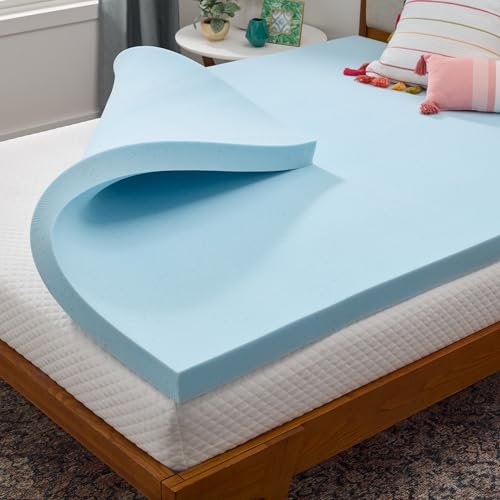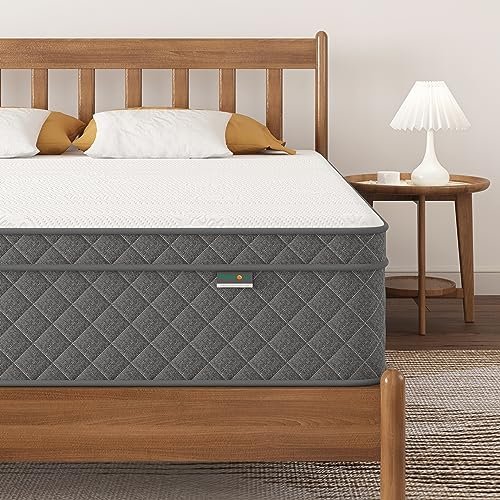
Sleep Soundly: Your Ultimate Guide on How to Make a Bed Frame More Sturdy (DIY & Easy Fixes!)
Recommended Product:
Ever feel like your bed has a mind of its own, rocking and creaking with every toss and turn? A wobbly or unstable bed frame isn’t just annoying; it can disrupt your sleep, potentially damage your mattress, and even be a safety concern. But don’t worry – you’re in the right place! Making your bed frame more sturdy is often simpler than you think, and you don’t need to be a DIY expert to achieve a solid night’s sleep.
In this detailed guide, we’ll walk you through common reasons for instability and provide step-by-step instructions, practical tips, and common mistakes to avoid so you can transform your shaky slumber spot into a sanctuary of stillness. Let’s get started!
Why Sturdiness Matters for a Good Night’s Sleep
Before we dive into the fixes, let’s quickly touch on why a sturdy bed frame is so important:
- Improved Sleep Quality: No more creaks or wobbles to wake you up! A stable bed promotes uninterrupted rest.
- Enhanced Safety: A loose frame can potentially collapse or cause minor injuries.
- Extended Mattress Lifespan: A properly supported mattress will wear evenly and last longer.
- Peace of Mind: Knowing your bed is secure allows you to fully relax.
Initial Assessment: Identifying the Source of Instability
Before you grab your tools, it’s crucial to understand why your bed frame isn’t sturdy.
- Empty Your Bed: Remove your mattress, box spring (if applicable), and any bedding. This allows you to inspect the bare frame.
- Inspect All Connections: With the bed empty, gently shake each section of the frame. Wiggle the headboard, footboard, and side rails. Look closely at where the pieces connect.
- Check Legs and Support: Examine the legs for any looseness, cracks, or unevenness. Also, inspect the central support beam and slats.
- Listen and Feel: Try to pinpoint the exact source of the movement or noise. Is it a loose bolt, a wobbly leg, or a sagging slat?
Once you’ve identified the culprit, you can apply the most effective solution.
Step-by-Step Solutions to Make Your Bed Frame More Sturdy
Let’s get hands-on!
1. Tighten All Fasteners (The First and Easiest Fix)
This is the most common reason for a wobbly bed frame and often the easiest to fix. Over time, screws, bolts, and nuts can loosen due to movement and weight.
- What you’ll need: A screwdriver (Phillips or flathead), an Allen wrench (hex key), or a spanner/wrench, depending on your frame’s hardware.
- Instructions:
- Locate every single bolt, screw, and nut connecting the headboard, footboard, side rails, and any central supports.
- Using the appropriate tool, tighten each fastener clockwise until it’s snug.
- Do not overtighten! This can strip the threads or crack the wood/metal, causing more damage.
- Repeat this process for all connections.
2. Add Corner Braces (The Unsung Heroes of Stability)
If tightening bolts doesn’t fully resolve the issue, especially at the corners where the side rails meet the headboard/footboard, corner braces are your best friend.
- What you’ll need: Metal L-brackets (often called corner braces), a drill, appropriate screws (short enough not to poke through the other side of your frame!), and a screwdriver.
- Instructions:
- Align an L-bracket into each internal corner where two frame pieces meet (e.g., side rail to headboard).
- Pre-drill small pilot holes where you plan to insert the screws. This prevents splitting wood.
- Securely screw the L-bracket into both pieces of the frame. Use at least two screws per side of the bracket.
- Repeat for all four corners of your bed frame for maximum stability.
- For extra reinforcement, you can add flat mending plates along the inside of longer joints.
3. Reinforce Slats and Bed Base (Preventing Sagging and Wobble)
Recommended Product:
The slats or bed base are crucial for supporting your mattress. Weak or insufficient support here can lead to sagging and overall instability.
- What you’ll need: Additional wooden slats, a sheet of plywood or bunkie board, a drill, wood screws, and possibly small L-brackets.
- Instructions:
- Increase the Number of Slats:
- If your existing slats are far apart (more than 2-3 inches for most mattresses), add more slats to reduce the gap.
- Ensure your slats are evenly spaced and firmly secured to the side rails using screws or small L-brackets.
- Add a Plywood or Bunkie Board Layer:
- For ultimate support and to prevent any slat movement, place a thin sheet of plywood or a bunkie board directly over your existing slats.
- Ensure the plywood fits snugly within the frame. You might want to screw it down in a few places to prevent it from shifting.
- This creates a completely flat, solid surface for your mattress.
- Increase the Number of Slats:
4. Stabilize Bed Legs (Stopping the Floor Dance)
Wobbly legs can make the entire bed feel unstable.
- What you’ll need: Furniture felt pads or rubber grippers, shims (wood or plastic), and possibly larger lag screws.
- Instructions:
- Address Uneven Floors:
- If your floor is uneven, place thin shims under the shorter legs until all legs make firm contact with the ground.
- You can also try adjusting the feet of your bed if it has built-in adjustable glides.
- Prevent Slipping:
- Attach rubber grippers or felt pads to the bottom of each leg to prevent the bed from sliding on smooth floors.
- For severe slippage, place a non-slip rug pad directly under each leg.
- Reinforce Loose Legs:
- If a leg is screw-in and consistently loose, remove it and wrap the threaded part with plumber’s tape (PTFE tape) before screwing it back in. This creates a tighter fit.
- For legs that are part of the frame, consider adding L-brackets to connect them more firmly to the side rails.
- Address Uneven Floors:
5. Introduce Center Support (Crucial for Larger Beds)
Queen, King, and California King beds are especially prone to sagging in the middle without adequate central support.
- What you’ll need: Adjustable bed frame support legs, a sturdy wooden beam (e.g., 2×4 or 2×6), drill, wood screws, and possibly small brackets.
- Instructions:
- Install Adjustable Support Legs:
- Many bed frames have a pre-drilled central support beam that runs from head to foot. If yours does, install adjustable support legs along this beam.
- Adjust the legs so they firmly touch the floor and provide upward pressure against the beam.
- DIY Central Beam:
- If your frame lacks a central support beam, you can create one out of a sturdy wooden 2×4 or 2×6.
- Cut the beam to fit snugly between the headboard and footboard.
- Securely attach small L-brackets to the inside of the headboard and footboard, then rest and screw the beam onto these brackets.
- Add adjustable support legs along the length of your new central beam (typically 2-3 legs for a queen/king).
- Install Adjustable Support Legs:
6. Combat Frame Movement with Anti-Slip Solutions
Sometimes, the entire bed frame moves on the floor, rather than just wobbling within itself.
- What you’ll need: Rubber furniture cups, non-slip rug pads, or furniture grippers.
- Instructions:
- Place rubber furniture cups or pads under each leg of the bed. These create friction and prevent sliding.
- For beds on hard floors, a large area rug under the entire bed can significantly reduce movement.
- As a more drastic measure for persistent movement, you could consider securing the headboard to the wall using wall-mounting brackets, but ensure you hit wall studs for security and proper installation.
7. Consider Frame Material & Design (Long-Term Stability)
While you might not be buying a new frame right now, understanding how materials and design affect stability can help for future reference.
- Solid Wood Frames: Generally very sturdy, but connections need to be well-made (mortise and tenon joints are excellent).
- Metal Frames: Can be very strong, but thin metal can bend or rattle. Welded joints are usually stronger than bolted ones.
- Platform Beds: Often inherently more stable due to their solid base or closely spaced slats and lower profile.
- Poorly Designed Frames: Frames with too few connection points, weak materials, or intricate, delicate designs can be harder to stabilize. A well-designed frame inherently offers more stability.
General Tips for Maintaining Sturdiness
- Regular Checks: Periodically check and tighten all fasteners (every 3-6 months is a good practice).
- Don’t Jump on the Bed: This puts excessive stress on the frame’s joints and supports.
- Proper Assembly: Always follow the manufacturer’s instructions carefully when assembling a new bed frame. Don’t skip steps or leave out hardware.
- Use Correct Mattress Support: Ensure your mattress is always supported by either a box spring (if required by the mattress manufacturer) or adequate slats/a solid platform.
Common Mistakes to Avoid
- Ignoring Initial Wobble: A small wobble can quickly turn into a major problem if left unaddressed. Fix it early!
- Overtightening Screws/Bolts: This can strip threads, damage wood, or deform metal, making the problem worse. Snug is good; straining is bad.
- Using the Wrong Tools: Using a screwdriver when an Allen wrench is needed can damage the fastener head and make it impossible to tighten properly.
- Forgetting Center Support: Especially for larger beds, a lack of central support is a recipe for sagging and instability.
- Not Checking for Levelness: An uneven floor can make even the sturdiest frame feel wobbly. Always address this first.
Enjoy Your Sturdy Sleep!
You’ve put in the effort, and now it’s time to reap the rewards! A little bit of DIY and attention to detail can transform your shaky bed frame into a bastion of stability. By following these steps, you’ll not only enjoy a better night’s sleep but also extend the life of your bed frame and mattress.
Sweet dreams in your newly sturdy, silent, and supremely comfortable bed!
Recommended Product:
Frequently Asked Questions
Q: How can I fix loose joints on my bed frame?
A: A. Loose joints are a primary cause of an unstable bed frame. First, identify all connection points, especially where the side rails meet the headboard and footboard. Tighten all screws, bolts, and nuts firmly with the appropriate wrench or screwdriver. If the hardware is stripped or missing, replace it with new, stronger fasteners. For wooden frames, you can disassemble the joint, apply wood glue to the dowels or tenons, reassemble, and clamp it until the glue dries for a more permanent bond. Consider adding metal L-brackets or corner braces to reinforce these critical junctures.
Q: My bed frame squeaks constantly. How can I stop it?
A: A. Squeaking usually indicates friction between two parts that should be held firmly together, or sometimes, a loose connection. Start by tightening all fasteners as described above. If squeaking persists, disassemble problem areas, and use furniture pads, felt washers, or thin pieces of cork between components that rub against each other, such as between slats and side rails, or where the frame connects to the headboard. For metal frames, applying wax or silicone spray to contact points can reduce friction and noise. Also, ensure the bed is level on the floor, as unevenness can cause strain and squeaks.
Q: What’s the best way to stabilize wobbly bed frame legs?
A: A. Wobbly legs can make the entire bed feel unstable. First, check if the leg attachment hardware is tight. If the leg screws directly into the frame, ensure it’s screwed in fully and securely. For legs attached with bolts, tighten them firmly. If the leg itself is splitting or damaged, it might need to be replaced. For legs that consistently wobble despite tightening, consider adding leg reinforcement brackets, which are metal plates that screw into both the leg and the frame, providing a much stronger connection. Ensure all legs have even contact with the floor; use furniture pads or shims under shorter legs if your floor is uneven.
Q: How can I add or improve central support for my bed frame?
A: A. Many bed frames, especially Queen, King, and California King sizes, require robust central support to prevent sagging and instability. If your frame lacks a center support leg or beam, add one. This typically involves attaching a sturdy wooden or metal beam running from the headboard to the footboard, with one or more adjustable support legs along its length. These legs should extend to the floor and be adjusted to firmly support the center of the bed. For existing central supports, ensure they are securely attached to the frame and that their legs are not bent or damaged.
Q: My bed’s wooden slats seem weak or are breaking. How can I reinforce them?
A: A. Weak or broken slats compromise mattress support and overall frame stability. Replace any broken slats immediately. To reinforce existing wooden slats, you can add more slats, reducing the space between them for better support. Alternatively, for wider slats, consider screwing them directly into the side rails from the top, which prevents them from shifting or popping out. For extra strength, you can add a piece of plywood or MDF board over the entire slat system (under your mattress) to distribute weight more evenly, ensuring the board is properly ventilated if your mattress requires it.
Q: What specific hardware can I use to reinforce the bed frame corners?
A: A. Corners are crucial stress points. Metal L-brackets or corner braces are excellent for reinforcement. These typically come with pre-drilled holes and should be screwed into both intersecting frame components (e.g., side rail and headboard/footboard). For heavy-duty reinforcement, particularly with wooden frames, consider using bed rail fasteners or bed hook plates, which are designed to create extremely strong, interlocking connections at the corners. Ensure the screws used are appropriate length to penetrate deeply without coming through the other side.
Q: Beyond fixing specific issues, what general maintenance makes a bed frame sturdier?
A: A. Regular maintenance is key to long-term sturdiness. Periodically (e.g., every 6-12 months), perform a thorough check of all nuts, bolts, screws, and other fasteners across the entire bed frame. Tighten anything that has loosened over time. Inspect the frame for any signs of cracking, splitting, or bending, especially in wooden joints or metal welds. Lubricate any metal-on-metal contact points with a silicone spray to prevent rust and squeaks. Ensuring your bed frame is consistently level on the floor also reduces undue stress on its components.
Q: Can I add structural bracing to my bed frame for extra sturdiness?
A: A. Yes, adding cross bracing can significantly improve a bed frame’s rigidity, particularly for wooden frames. For side-to-side stability, you can install diagonal braces (often smaller pieces of wood) at the inside corners of the frame, screwing them into both the side rail and the head/footboard. For longitudinal stability, especially on larger beds, you can add additional support beams that run parallel to the existing side rails, or even perpendicular cross-beams beneath the slats, provided there’s room. Ensure any added bracing doesn’t interfere with the mattress or foundation and is securely attached.
Q: Are there different approaches for making wooden versus metal bed frames sturdier?
A: A. While many principles overlap, there are material-specific considerations. For wooden frames, wood glue is an invaluable tool for loose joints (in addition to hardware), and adding wood blocks, dowels, or corner gussets can provide excellent reinforcement. Always pre-drill holes to prevent wood splitting when adding screws. For metal frames, ensure all welded joints are intact and not cracked. Tightening bolts is paramount, as metal-on-metal friction can cause squeaking, which can often be solved with plastic washers or silicone spray. If a metal frame leg is bent, it might need professional repair or replacement, as bending it back could weaken it further.
Related Articles
7 Top Full Size Bed Frames: What is the Dimensions of a Full Size Bed Frame and More!
Getting a good night’s sleep often starts with the right bed, and for many, a full-size bed is the perfect sweet spot between a twin and a queen…
How Much Is a King Size Sleep Number Smart Bed
How Much Is a King Size Sleep Number Smart Bed? Your Guide to Understanding the Investment Recommended Product: Select Comfort Air Bed Chamber for Sle…
How Much Does a Sleep Number 360 Smart Bed Cost
How Much Does a Sleep Number 360 Smart Bed Cost? Recommended Product: Sven & Son Classic Adjustable Bed Base — head and foot lift, massage, under-…



